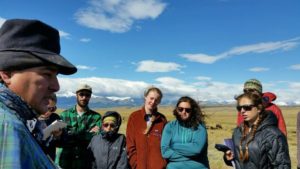
A lot goes into our perception of the West, and a conversation with two Montana grass growers can help clarify what actually shapes the landscape. Our WRFI group was lucky enough to speak with both a bison herd manager on the Blackfeet Reservation and a conventional cattle rancher near the town of Choteau, both along the Rocky Mountain Front. Sheldon, the Blackfeet Buffalo Herd manager and Lane Yeager, the rancher, have similar sounding job descriptions but do things very differently for very different reasons.
Sheldon, as manager of the Inter-Tribal Bison Herd oversees the population of 515 animals and growing. He spends most of his energy maintaining water sources and fencing on the property. He also makes sure the bison are keeping a healthy weight by feeding them hay when they’re looking slim. With an abundance of help, he moves the entire herd from winter to summer pasture over the course of several days at the change of seasons. When other bison herds around the state have a surplus of animals, Sheldon can add to the Blackfeet’s herd. Unlike many ranching operations, the bison aren’t given shots or vaccines, or protected from predators like wolves. The two-year-olds are harvested for multiple purposes, including consumption and spiritual use. The meat is given to families or individuals in need on a regular basis and in special circumstances, like the recent fires affecting the town of Fort Butte. Because of the spiritual significance of the bison to the Blackfeet, hides are gifted to Tribal Council members, cut for the Sundance Ceremony. Hooves are used in a mating dance. The tongue is used in ceremonies. The bison also provide a source of income to the tribe through meat sold to restaurants in California and hides sales. As a member of the Blackfeet Nation, Sheldon’s heritage influences how he sees bison in the landscape and as an inherent part of his tribal life.
Heritage is also a big reason why Lane Yeager continues to raise calves on his family’s seventh generation ranch. His main task is “turning grass into cash.” He similarly maintains fencing, facilitates calving, and controls weeds on his property. Calves born in the spring are weaned and shipped to feedlots in the Midwest around October of the same year. They’re given vaccines and growth hormones during their life on the ranch and feed mostly on native grass pasture. Some land is utilized as irrigated hay fields and sold to other farms. One of Lane’s greatest challenges as a rancher is dealing with wildlife damage to fences and pasture, a legitimate problem for a property surrounded by land managed for wildlife.
What can we learn from comparing these two grass growers? How can we understand the similarities and differences among individuals making a living on and from the land? Both Lane and Sheldon are raising controversial species in a controversial landscape. Buffalo, despite being a native species to the Montana prairie, are legally considered a livestock species and not managed in the wild by the Department of Fish and Wildlife. Lane argues that cattle have replaced bison in the ecosystem here, and many ranchers fear the potential of bison destroying fences. Others argue they are a critical part of this place and should be reintroduced in the wild. Cattle, on the other hand, receive criticism for overgrazing. Despite the land use issues relating to the two species, Lane and Sheldon are motivated by their love for this landscape, the one they work and live on. Listening to and connecting with people and their stories should inform our perception of what is seen as right or wrong when developing a land ethic because people, like Lane and Sheldon, are an important and fundamental part of the land.
How can we capitalize on the common goals of such individuals to conserve the Rocky Mountain Front?